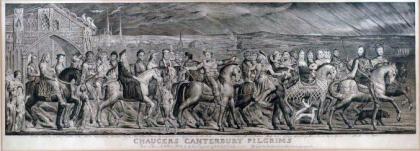William Blake (1757-1827) had only one exhibition and received only one published review in his lifetime. We are celebrating the 200th anniversary of this 1809 show, held at 28 Broad Street (the same building where Blake was born) on the second floor above the family shop now run by his brother Robert. Six visitors paid 2s 6d to attended, including Robert Hunt, a reviewer from The Examiner, who wrote: “The poor man fancies himself a great master, having painted a few wretched pictures, blotted and blurred and very badly drawn … [Blake is] an unfortunate lunatic whose personal inoffensiveness secures him from confinement.”
For the show Blake wrote and published a Descriptive Catalogue, along with an index to the works in the exhibition. The title page reads (spelling is Blake’s) “In this Exhibition will be seen real Art, as it was left us by Raphael and Albert Durer, Michael Angelo and Julio Romano; stripped from the Ignorances of Rubens and Rembrandt, Titian and Correggio; By Wm Blake.” Happily, this ephemeral catalogue only known to most of us from notes in a history book, can now be seen in person at separate exhibitions in London and in Paris, or you can buy the reprint recently published by Tate Britain.
Blake’s purpose in mounting this poorly attended exhibition was to highlight his interpretation of Chaucer’s Canterbury Pilgrims, and prove the superiority of his work over the one exhibited in 1806 by publisher Robert Cromek and the artist Thomas Stothard. Blake had given Cromek the idea for a Chaucer print and was angry when a more commercial artist was chosen to accomplish it. Blake responded with both a tempera painting “Sir Jeffery Chaucer and the Nine and Twenty Pilgrims on their Journey to Canterbury” for the 1809 exhibition and in 1810, this engraving.
“Every age is a Canterbury Pilgrimage,” wrote Blake in his catalogue, “We all pass on, each sustaining one or other of these characters, nor can a child be born who is not one of these characters of Chaucer.”
